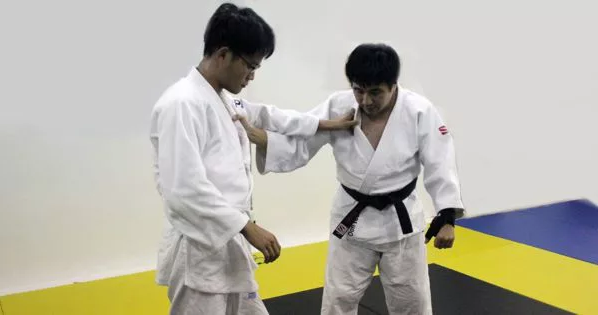In Lesson 2, I addressed three different responses a right-handed player could opt for when faced with a dominant right-handed gripper. Of course the same principles would apply if a left-hander faced a dominant left-handed gripper.
In this lesson, I will address what a right-hander can do when facing a strong left-hander (again, the same principles would apply if a left-hander faced a strong right hander).
In the case of righty vs righty, there will be a strong battle to establish a Kenka-Yotsu formation, with the dominant one taking a right stance and the weaker one settling for a left stance. We established that in Lesson 2.
In contrast to that, in the case of a righty vs lefty, there is no need to fight for a Kenka-Yotsu formation. It will just happen naturally. The lefty would naturally approach the righty with his left arm and left leg forward. Meanwhile, the righty would naturally approach the lefty with his right arm and right leg forward. Their stances naturally result in a V-shaped formation (see picture above).
The grip fight will be over hand positioning. If a player likes to do seoi-nage, he will aim to get an underarm grip. If a player prefers to do uchimata, he will prefer an overarm grip. So depending on who likes what kind of throw, you will have a fierce battle over hand positioning. For throws like uchimata, harai-goshi, osoto-gari and ouchi-gari, players generally prefer the overarm grip. For throws like seoi-nage, tai-otoshi and kouchi-gari, players generally prefer the underarm grip.
If you're not clear what an overarm and an underarm grip are, see the picture at the top of this page. The lefty player has an overarm grip and the righty player has an underarm grip.
For ease of illustration, let's call the lefty, Player A; and the righty, Player B. Now, let's look at the various scenarios and various options from the standpoint of Player B:
Scenario 1: Player A likes uchimata (overarm grip). Player B likes seoi-nage (underarm grip)
- Player A gets his overarm grip while Player B gets his underarm grip
- Player A tries to get an overarm grip but Player B refuses to give it to him
- Player A tries to get an overarm grip but Player B catches Player A's arm and locks it down so that Player A cannot even get a lapel grip at all.
Option 1 is 50:50. Nobody has an advantage. Both have the stance and the grip they want. Now it's just a matter of who's the better thrower. If Player B is a good thrower, he likes this scenario because although it's 50:50, he is confident he can throw Player A.
Option 2 is when Player A is a better thrower. Player B know this and refuses to let Player A get the grip positioning that he wants. If Player B does this for too long, he will get a shido. But better a shido than being thrown for ippon.
Option 3: This is when Player A is a really great thrower and Player B knows once Player A gets his grip, it's all over. Player B aims to completely disable Player A's throwing ability by catching his arm and locking it down, preventing him from even getting a lapel grip.
In this scenario, if Player B is a good thrower, definitely go for Option 1. If B is not as good as A in throwing, he should either go for Option 2 or 3 and try to get a win by some other means (for example, through newaza or forcing Player A to get three shidos).
Scenario 2: Player A likes seoi-nage (underarm grip) and Player B likes uchimata (overarm grip)
- Player A gets his underarm grip while Player B gets his overarm grip
- Player A tries to get an underarm grip but Player B refuses to give it to him
- Player A tries to get an underarm grip by Player B catches Player A's arm and locks it down so that Player A cannot even get a lapel grip at all.
The three options are the same as above in Scenario 1, that is:
Option 1 is 50:50 and the better thrower will win
Option 2 is spoiling Player A's chances to throw
Option 3 is completely preventing Player A from even getting a lapel grip.
The conclusion is also the same as Scenario 1. If Player B is a good thrower, go for Option 1. Otherwise go for Options 2 or 3 and try to win through other means besides throwing.
Scenario 3: Player A and Player B both like uchimata (overarm grip)
- Player A dominates and manages to get his overarm grip. Player B submits and settles for an underarm grip.
- Player A tries to get an overarm grip but Player B refuses to give it to him..
- Player A tries to get an underarm grip by Player B catches Player A's arm and locks it down so that Player A cannot even get a lapel grip at all.
- Player B dominates Player A, who submits. Player B ends up with the overarm grip while Player A settles for an underarm grip.
Option 1 is a terrible idea. Never do this. Once Player A gets the grip he wants and forces Player B to adopt a grip he doesn't want, Player A obviously has the advantage. Avoid at all costs.
Option 2 is spoiling and Option 3 is an extreme form of spoiling. Neither is great and could result in shido but it's better than being thrown for ippon.
Option 4 is the ideal one. This is what Player B must strive for.
Scenario 4: Player A and Player B both like seoi-nage (underarm grip)
The same principle as Scenario 3 applies.
Option 1 means letting Player A gets what he wants (in this case, the underarm grip).
Option 2 and 3 are for spoiling.
Option 4 is where Player B gets the grip he want (in this case, the underarm grip).
As you can see, from the standpoint of a righty, fighting a lefty is a lot more complicated than fighting a righty.
When a righty (Player A) fights a righty (Player B), the options for Player B are simple and straight forward:
- Submit to A and take a lefty stance. Avoid.
- Force an Ai-Yotsu situation and end up in 50:50. Acceptable.
- Impose your grip on A and force A into a lefty stance. Ideal. Simple, right? (Just go for Option 3 all the time).
In a lefty (Player A) vs righty (Player B) situation, things become a lot more complex for Player B. who has to quickly establish whether A likes an overarm or an underarm grip, and then decide what to do depending on B's prowess in throwing.
If B is a stronger thrower than A (i.e. B wants to throw)
In Scenarios 1 and 2, it is fine for B to settle for Option 1: the 50:50 situation.
In Scenarios 3 and 4, B should go for Option 4, all the time.
If B is a weaker thrower than A (i.e. B wants to spoil and win by some other means)
In Scenarios 1 and 2, B must avoid Option 1, and go for Options 2 or 3.
In Scenarios 3 and 4, B must avoid Option 1, and go for Options 2, 3 or 4.
Now you know why people hate fighting lefties!

